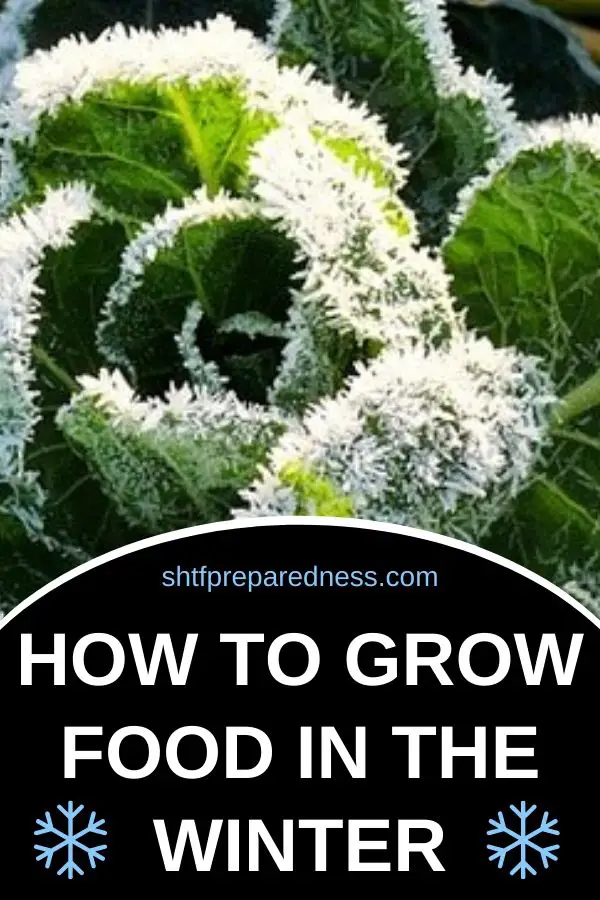Do you miss plucking fresh fruits, herbs or veggies from your garden during winter? Do you wish to enjoy beautiful organic produce during the cold months?
You are just in the right place. This write-up is dedicated to all the essentials necessary to learn how to grow food in the winter.

There are lots of things to think about in preparation for winter food gardening!
- What will you need?
- How to prepare the soil?
- Which tools to have handy?
- How to apply the mulch?
- Which vegetable or fruits to pick?
- How to go about the entire process?
How to Grow Food in the Winter?
What do you need for a successful winter garden?
While the colder areas could benefit from a cold frame, many areas are mild enough to grow vegetables right in the outdoor garden.
Here’s what you’ll need for planting your cold-weather garden:
- Garden clean-up tools: rake, leaf blower, tiller, etc.
- Mulch & compost
- Soil pH tester: a digital soil ph tester is pretty convenient
- Seeds of the crop you wish to grow
- Wooden planks for raised beds
- Gloves: for all those who like their hands tidy while gardening
Vegetables suitable for winter cultivation
- Arugula
- Asparagus
- Broad beans
- Broccoli
- Cabbage
- Carrots
- Garlic
- Kale
- Lettuce
- Onion
- Parsley
- Peas
- Spinach
Besides these vegetables, you can opt for your personal favorites. Pick any veggie that you love to toss in your warm winter soups or sandwiches.
The added benefit is that cool-weather vegetables taste much more delicious when exposed to the cold.
5 Steps to Planting Arugula in the Winter Garden
Follow these 5 steps to prepare your soil for any winter vegetable cultivation. We especially like arugula, but this process works for all winter crops.
Step 1: Clean Garden Beds
First and foremost, cleaning up is a must. All the dead summer plants, rotten fruits and vegetables, etc. need to be cleared.
After all, you wouldn’t want pests accumulated in the summer garden deposits to spoil your brand new winter crops.
Were your previous season veggies affected by mold, mildew or blight? If yes, take out your trash bin, collect all the foliage, and dump it. You can also pile them up and burn.
Burning cuts down or eliminates mold and mildew from spreading to the compost.
Step 2: Apply Mulch and Compost
If you had applied mulch before, scoop that aside! Pluck out any weeds that you see. Place about 1 or 2 inches of compost. Apply the mulch on top of the compost as a thin covering.
To keep the soil from completely freezing up, you need a thick layer of mulch. Mulching curbs weed growth and safeguards the soil.
Step 3: Test the Soil
Testing the soil is the easiest way to find out if your soil has the nutrients it needs. If not, you will know how many nutrients need to be added to make the soil fit for growing your chosen winter vegetation.
Soil tests usually determine:
- The soil’s pH level
- Potassium, calcium, phosphorus, sulfur and magnesium levels
- amount of lead in the soil
Once the test is done, check if the pH level is normal. If not, you will need to add lime to the soil to correct it. Since lime needs time to dissolve in the soil, I prefer to add it during fall.
Step 4: Plant Your Seeds
Arugula, one of our favorite winter veggies, is very popular as a green salad. It tastes somewhat spicy & sharp!
This crop belongs to the cabbage family. It can endure light frosts & fair freezes. Its leaves, flower buds and flower petals are edible. The leaves double up when added to soups.
It’s best to harvest the leaves when they’re young.
- Placement: Position the crops either under full sunlight or partial shady spots.
- Soil: Prepare fertile, well-drained soil with compost. It should be able to retain moisture.
- Sowing: Plant your seeds during the fall by applying a light layer of mulch.
- Distance: For single arugula plants, maintain a space of 15cm on every side. If you wish to plant in rows, then maintain a row gap of 10cm & 20cm.
- Watering: Don’t water arugula too much, as its roots tend to drown easily.
Step 5: Watch out for Flea Beetles
Keep an eye on flea beetles. If you see any tiny holes in your arugula leaves, it means an attack by flea beetles.
To protect your arugula plants from flea beetles, you can try homemade garlic spray or buy an organic insecticide, like PyGanic.
Indoor Winter Garden
If you live in an area with very cold winters, you might need to create an indoor area for your veggies. Make sure your winter garden space has lots of sunlight.
A south-facing windowsill is a great spot. It will get lots of sunlight during the day, helping your plants develop.
Plant multiple leafy greens in your winter garden; lettuce, spinach, edible flowers, and herbs are everyone’s favorites.
How to Save Vegetables From Freezing
Follow these tips to save your cold-resistant vegetable from freezing:
- Get frost protection cloth
- Try out raising the sides of your garden beds and using a lid covering (basically creating a cold frame)
- Use a hoop house
- Planting in a greenhouse always helps
- Plant indoors using grow bags, tubs, buckets, and plastic containers. You can also use straws or ice-cream sticks to insulate the soil and save it from freezing up.
You are now ready to enjoy fresh herbs and vegetables throughout the cold season now that you have learned how to grow food in the winter. Enjoy your fresh veggies and herbs!
